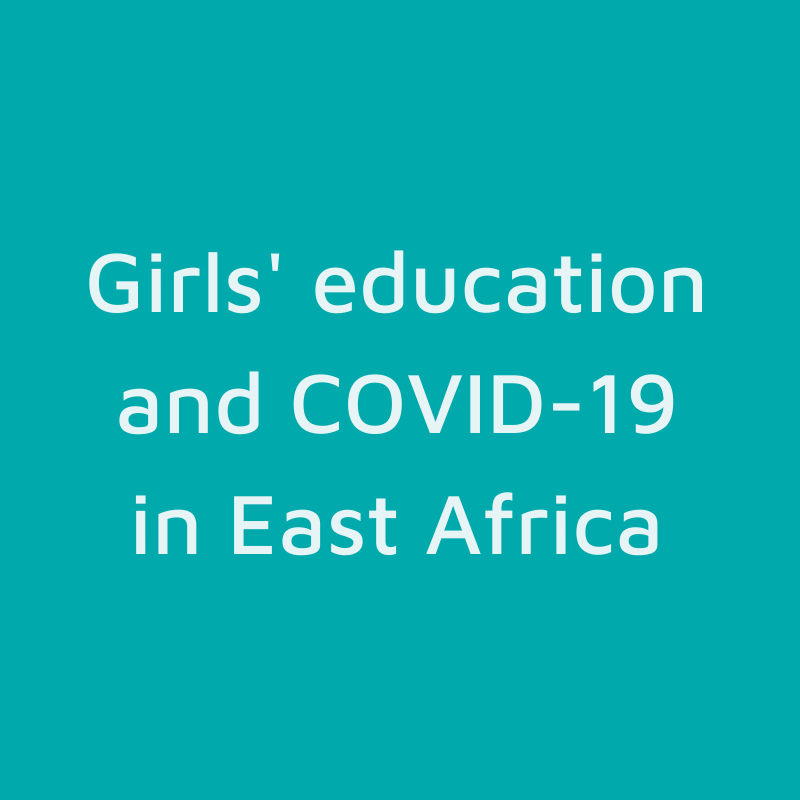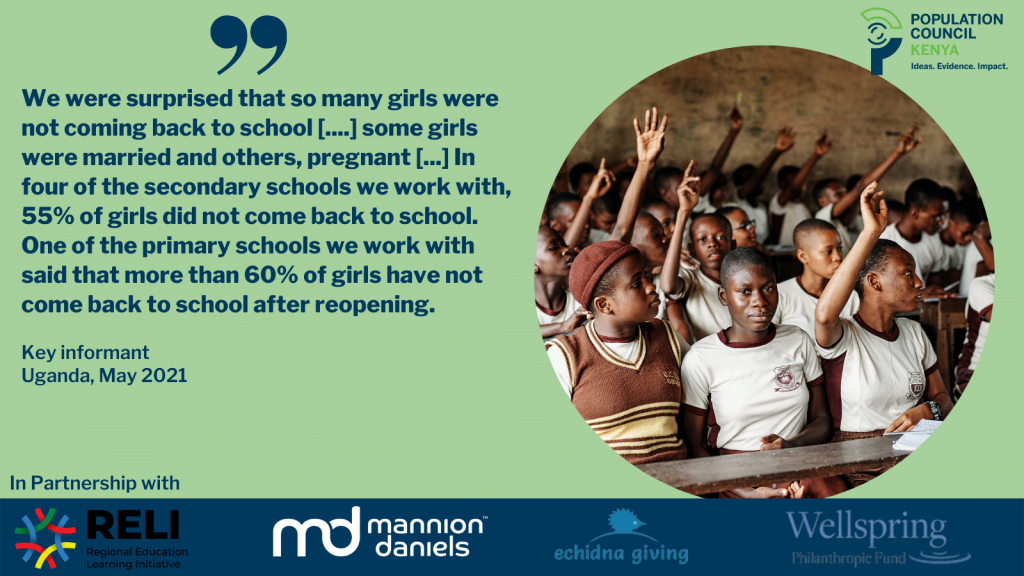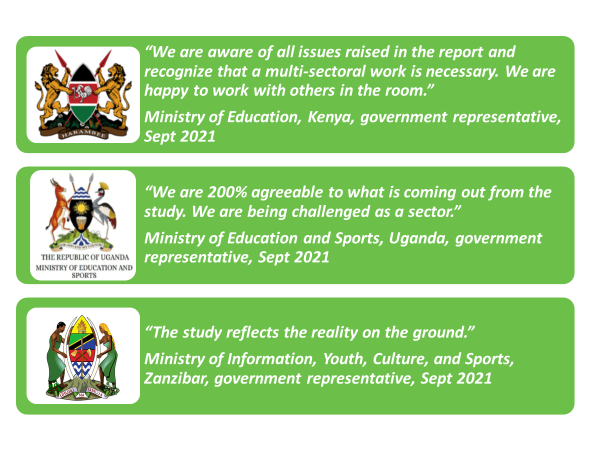News
Girls’ education and COVID-19 in East Africa: learnings from the Regional Education Learning Initiative and other stakeholders

By Yoko Akachi, Rolla Khadduri and Chi-Chi Undie[1]
Over a billion students globally have been affected by school closures since March 2020 due to the COVID-19 pandemic. Understanding the present state of girls’ education is important as the pandemic persists and the disruption in education creates severe learning, health, and well-being risks.
The Population Council, Kenya; the Regional Education Learning Initiative (RELI); and MannionDaniels conducted a study to understand the current problems posed by COVID-19 for girls’ education in Kenya, Tanzania, and Uganda. The study also aimed to identify knowledge gaps and to illuminate solutions for implementers and policymakers to take forward.
We conducted a rapid desk review of peer-review and grey literature, coupled with nearly 30 key informant interviews with a range of East African organizations working on education and/or gender issues. These methods were complemented by an interactive, participatory workshop during which interviewees and other education stakeholders validated and supplemented the initial study results. We summarise key findings from the study below.
How have girls been affected?
The pandemic brought about school closures and the geographical displacement and economic distress of many families. Being out of school led to various pressures on girls’ health and well-being. Many did not return to school due to distractions from income-generating activities that they had commenced to deal with family economic pressures during the pandemic. Many others remained out of school because they ended up getting married or pregnant during lockdowns. Other reproductive health issues such as sexual and gender-based violence (including female genital mutilation), transactional sex, and sexually transmitted infections are reported to have increased during school closures.

What solutions are needed?
Organizations we spoke to proposed solutions that they have effectively implemented at community-level during the pandemic, or that they had used successfully during other crises, including the following:
Immediate solutions:
- Attend to girls’ basic needs and psychosocial support requirements, while keeping them engaged in learning despite school closures
Longer-term solutions:
- Bolster parental engagement in girls’ learning
- Engage school leadership, given their influential role in determining how schools work
- Accelerate the digitalisation of education, while simultaneously narrowing the acknowledged digital divide
- Foster government-NGO collaborations for greater impact
- Initiate a process that would lead to transformative education for girls, thus modifying the education system in ways that would mitigate the fundamental problems in girls’ education revealed by COVID-19.
How do we move forward from here?
Early in the pandemic, Ministries of Education (MoEs) in the East African region attended swiftly to anticipated issues in the education sector, including through the development of education response plans. These response plans were necessarily illustrative in the context of this unprecedented pandemic. A year and a half into the pandemic, evidence on the state of girls’ education has accumulated, and the East African region is at an opportune time and place to review MoE COVID-19 response plans.
As part of an effort to do so, we convened a virtual policy forum that brought together policymakers, NGOs, and donors in September 2021. The above-referenced study was used as a starting point for informing the adaptation and implementation of education sector COVID-19 response plans in the region. We sensitised the decision-makers to the evidence accrued, identified specific areas in which the evidence could directly inform the response plans, and fostered partnerships for specific actions. The remarks of decision-makers during this forum (and highlighted below) demonstrate political will to address emerging issues in girls’ education during the pandemic.

Some of the main take-away messages from the forum revolved around pregnant and parenting girls, as follows:
Continued education and support for pregnant and parenting girls require particular focus.
Although the issue of pregnant and parenting girls was brought up by essentially all NGOs across the three countries, currently, none of the national response plans specifically addresses this group of very vulnerable students. National plans can be further improved by incorporating interventions that benefit such girls.
The gap between policy at the top and the implementation on the ground requires bridging.
Lack of information and coordinated communication inhibits policy translation and dissemination across schools and communities. Implementing organizations and researchers in the region are well-positioned to help attend to this issue (feeding sub-national information to the government about what is happening within communities and schools), which is particularly relevant to school re-entry guidelines for pregnant and parenting girls in the region.
These messages are timely, given the political will expressed by governments in the region around this population of girls, particularly in the context of the pandemic. For example, in Kenya (where concerted efforts were made prior to COVID-19 to ensure the return of parenting and pregnant girls to school, and were redoubled during the pandemic), there are ongoing processes by the MoE to develop a national implementation plan and monitoring tool for the country’s re-entry guidelines. In the last week of November 2021, the Tanzanian government announced the lifting of its ban on school re-entry for parenting girls, and the World Bank commended this important move, signalling the potential for much more progress to be made on this issue in the coming years. In the wake of the COVID-19 pandemic, the Ugandan government revised its school pregnancy guidelines specifically to address gaps in re-entry support for affected girls.
The alignment of these important government actions with the voices of RELI and other stakeholders (which represent the voices of girls in the East African region) indicate that the time is ripe for a real change in terms of access to education for marginalised girls. The cost of not building on this momentum could very well be a generation left behind.
For further reading: Population Council, Regional Education Learning Initiative, & MannionDaniels. (2021). Advancing Girls’ Education in Light of COVID-19 in East Africa: A Synthesis Report. Nairobi, Kenya: Population Council.
[1] Yoko Akachi, independent consultant
Rolla Khadduri, Head - Gender and Social Development, MannionDaniels
Chi-Chi Undie, Senior Associate, Population Council; Co-Lead, Equity & Inclusion Thematic Group, RELI Kenya


